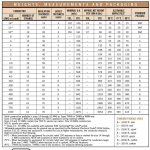I am a bit unsure on how to proceed with this inquiry, any assistance would be very much welcomed.
The 2011NEC now specifically requires that termination lugs used with finely stranded cable should be listed/marke for such use. This eliminates 99% of all mechanical lugs. I believe there is one mechanical lug that is allowed (Greaves P-type clamp).
This is not a problem for me until we opened up the alternator/terminal cabinet of a generator with a factory installed 400A breaker. The breaker has mechanical line lugs and the cable from the alternator is finely stranded. The cable ends are stripped and wrapped in copper tape before they inserted in the mechanical lug. Are they in violation of NEC? Are they even bound by NEC?
NEC defines their coverage downstream from the service point, ART 90.2 (A). Does this allow the manufacturer to claim that the breaker is behind the service point and is not bound by NEC? Rather they are bound by UL listing/testing of the equipment as a whole.
Any help in clarifying? I am also looking for source references.
There is a Square D whitepaper saying that it is normal practice for OEM to use copper wrapped cables into mechanical lugs. i am assuming if you open up a SQD switchboard or MCC with direct connect device, they do use this procedure to tap onto the horizontal bus. Are they claiming the same thing "what is manufactured inside the device is not covered by NEC"? as NEC only covers the installation of such devices.
sorry for the long winded narration....just wanted to convey all my thoughts as i solicit yours
The 2011NEC now specifically requires that termination lugs used with finely stranded cable should be listed/marke for such use. This eliminates 99% of all mechanical lugs. I believe there is one mechanical lug that is allowed (Greaves P-type clamp).
This is not a problem for me until we opened up the alternator/terminal cabinet of a generator with a factory installed 400A breaker. The breaker has mechanical line lugs and the cable from the alternator is finely stranded. The cable ends are stripped and wrapped in copper tape before they inserted in the mechanical lug. Are they in violation of NEC? Are they even bound by NEC?
NEC defines their coverage downstream from the service point, ART 90.2 (A). Does this allow the manufacturer to claim that the breaker is behind the service point and is not bound by NEC? Rather they are bound by UL listing/testing of the equipment as a whole.
Any help in clarifying? I am also looking for source references.
There is a Square D whitepaper saying that it is normal practice for OEM to use copper wrapped cables into mechanical lugs. i am assuming if you open up a SQD switchboard or MCC with direct connect device, they do use this procedure to tap onto the horizontal bus. Are they claiming the same thing "what is manufactured inside the device is not covered by NEC"? as NEC only covers the installation of such devices.
sorry for the long winded narration....just wanted to convey all my thoughts as i solicit yours


